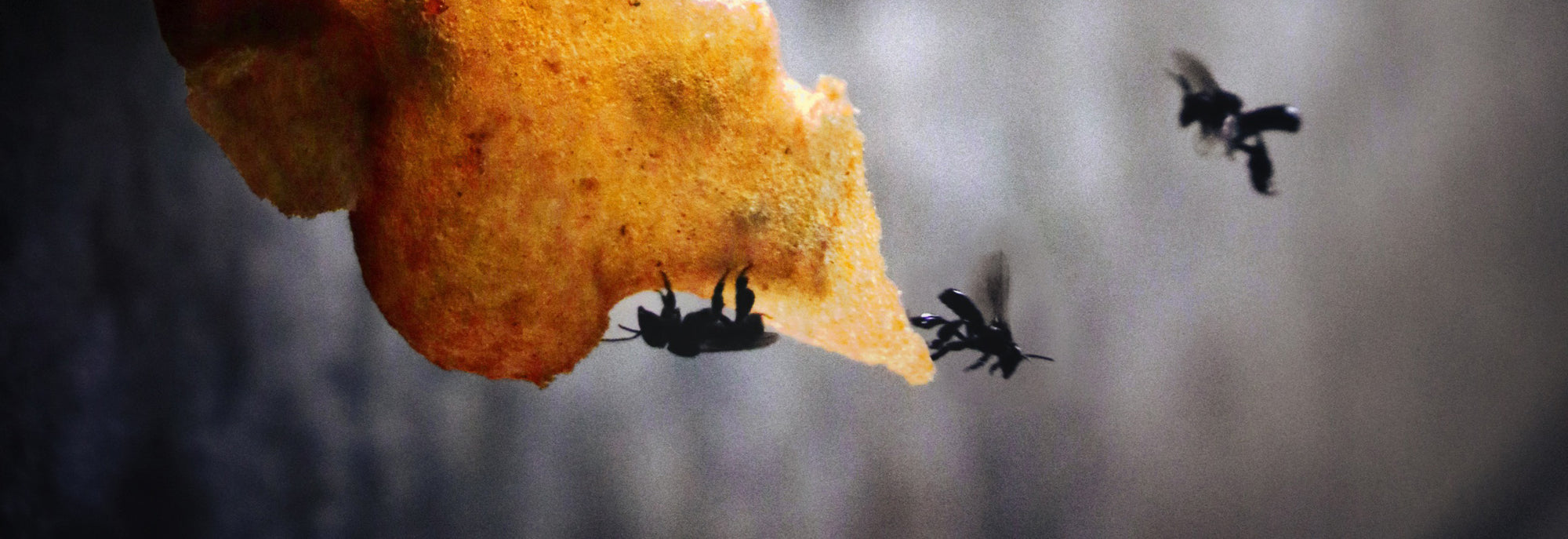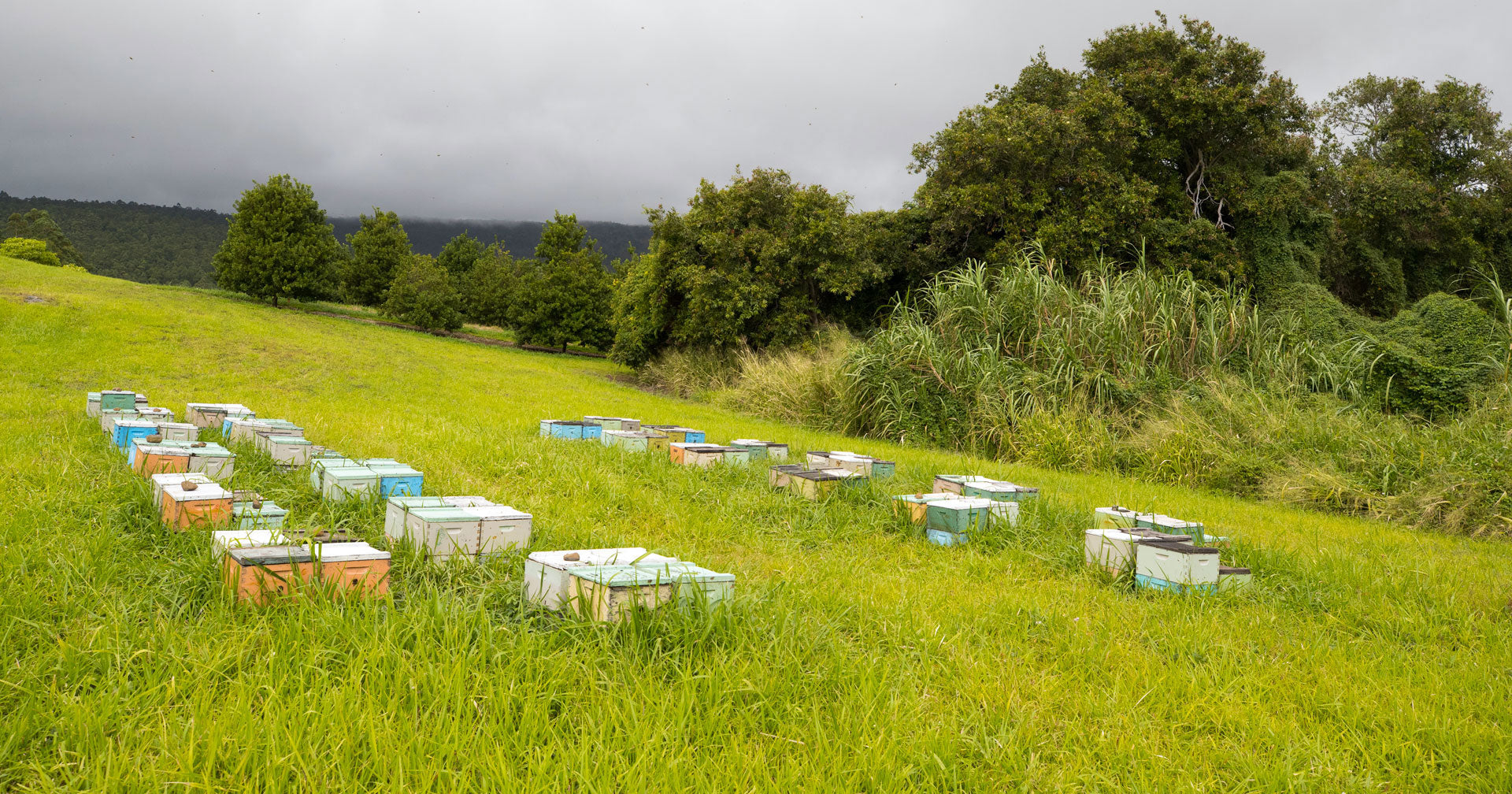When we think of bees in action, we often default to thinking about honey bees. The term honey bee is really the common name for an entire category of biological classification known as the genus Apis under which there are multiple bee species that produce honey. Here at Big Island Bees, our beekeepers work with the European honey bee—the most common honey bee and one of only two domesticated honey bee species. Each hive can produce upwards of two hundred to three hundred pounds of honey. With twenty-five hundred hives that can be upwards of half a million pounds of honey in a single year! But high production of honey is actually a rare quality for a bee, as most other species of bees produce little to no honey at all. In fact, there are thousands of types of bees that are not classified as honey bees and that you might not even recognize as a bee at all (which I have a personal story I’ll tell you about this below).
Of the 20,000 species of bees found around the world, less than 4% produce honey and less than 8% produce conglomerative social nests (beehives) like our European honey bees. Most species of bees are actually solitary or sub-solitary, coming together for mating and reproduction and gathering just enough resources to feed themselves and few young throughout the productive season.
Which Types of Bees Make Honey in the U.S.?
Only about 4,000 of the world’s bee species are native to the United States, of which not a single one is known for producing honey! That may seem unbelievable given the millions of colonies of honey bees that exist in North America today, but it’s true—all the honey bee species we encounter in our backyards or that produce our honey in North America were introduced to the region by European settlers.
While we may not have any native honey producing bees in the U.S., we don’t need to travel far to find some. Mexico and Central America, are known for having 16 unique species of what we commonly call stingless honey bees or scientifically call the genus Melipona—a large category of bees separate from our familiar honey bees that is also known for making honey.
Do All Stingless Bees Make Honey?
Again, stingless is a common term that generally refers to Melipona bees, however there are also other types of bees that cannot sting. This includes many solitary bee species and even certain bees within a sting-able species, such as drone (male) honey bees. The stingless bee Melipona is well known for its highly-prized honey in many parts of the tropics. Although they do not produce as much honey as the European honey bee, these stingless bees produce enough to feed their hive with a small amount of surplus for tasting. They can be found in the wild and are also kept by local beekeepers in regions where they are native.
My Personal Quest For The Mexican Stingless Honey Bee
I was fortunate to have the opportunity to taste the rare stingless honey bee honey myself on a recent trip to Mexico. To be honest, it was more of a quest; I was in pursuit of a stingless bee species unique to the very area I was visiting.
My first step was to scout out a local beekeeper. I chose a "more is more" approach to searching for these bees, excitedly asking about these stingless honey bees to anyone who would listen. To my surprise, despite the fact that almost all of the local guides and public alike knew of the native species, none knew of a place to visit for a first-hand introduction to this unique indigenous species. I found out that most of the so-called local beekeepers were really just backyard beekeeping for their family’s consumption – similar to the bees themselves, with little surplus.
Eventually I got lucky and ran into a local woman outside the grocery store carrying and showing tiny jars of honey. They looked to be precisely what I was looking for. After a quick conversation and translation, I learned that this was indeed the honey from the stingless bees I was in pursuit of.
Of course it wasn't that the woman was being stingy (read sting-gy)! The jars were that tiny because the native species of bee known as the Royal Lady or the Xunan Kab, produces less than a liter of honey a year. I knew this honey was not only precious to me, it was precious to all of the natives. This honey had been revered since the Mayans—a historically unique medicine to the native culture. It was fortuitous to find some for sale.
The taste of the honey was incredibly unique. She had two different extractions; the first was very smooth and viscous with sharp lemony notes, while the second was more granular with an almost chalky aftertaste (which I absolutely loved).
I was so thrilled I bought everything this lady had to offer. I assumed the third item was royal jelly and without confirming, took a big dollop off my finger and onto my tongue. That turned out to be a big mistake. I immediately found out the third item was a honey lotion that should not be eaten! Still, it didn’t phase me. I was at the pinnacle of success in my quest. I had found and savored this rare, one-of-a-kind honey. An experience I will never forget.
A Serendipitous Encounter
Finding their honey, I thought, was lucky enough. I realized that turning over every stone across Mexico to look for a tiny indigenous bee might not be as exciting for the people with whom I was traveling. I beat myself up a little bit. "I should have prepared more, done even more research, and started the quest months before my trip." Feeling dejected and a bit foolish for thinking I could find an insect on a whim, I gave up on my search for the bees themselves.
Then one hot afternoon, I took a break after walking and sweating in the humbling Mexican sunshine having gotten separated from our group while on a tour.. I sat on a rock wall with my friend to try and locate our group. After a few moments, my friend curiously asked why there was a commotion of what appeared to be flies right between my feet. To my surprise, they weren't flies but the stingless honey bees I’d given up on! I took pictures and intently watched their bee-haviors until we were reunited with our group (who were not as impressed with the discovery as I was.) For me, however, it was literally a dream come true.
The encounter was as much a lesson about life as it was about searching for wildlife.. Sometimes, like a Chinese finger trap, the harder you pull (or push for something), the harder it becomes to reach your goal. When that happens, it can be good to take a step back and let go of your struggle for a moment. You might just get lucky and realize that the solution is right under your nose (or between your feet).
Where Else Do Stingless Bees Live?
There are many species of stingless, or Melipona bees that are found throughout the tropics. Each regional species tends to be a unique pollinator to the specific local area to which it is native. This means that they would not do well outside their native environment and therefore cannot be domesticated on a world-wide scale.
What Does Stingless Bee Honey Taste Like?
Just like the Mexican bee honey I was fortunate to sample, Melipona honey is known for being a little less sweet than European honey bee honey and either lemony or other sour tone. This is due to common characteristics of the molecular makeup of the honey such as a higher water content. However, the main factor that determines the flavor of honey is the floral source from which the nectar is derived. Every area that has native stingless bees has its own unique flora that influences the taste of the honey.
That's the Buzz About Bees
I hope you enjoyed coming along with me down memory lane and learning about the incredible diversity—or shall I say bee-o-diversity—found amongst these remarkable insects. As you just read, most bees are not honey bees and we have yet to discover them all! Scientists and "backyard scientists" continue to find new species of bees, some that make honey and others that do not. I encourage you to look around your yard or take a peek into a wildflower field and get curious about the bees you see around you. You might find them interesting to watch and want to learn more about the native bees in your region. You can even take steps to help the wild bee population in your own backyard. Visit our post on creating a bee-friendly yard here.
Joe O'Brien, the author of this post, is our Senior Bee Docent and is known for his enthusiasm for and knowledge about all things bees. If you ever find yourself on the Big Island in Hawaii, he'd love to show you more about bees with an up-close and personal look into a beehive on our Beekeeping Tour!
Big Island Bees is an artisanal producer of three unique Hawaiian honey varietals. Our honey is raw and unfiltered and we tend to our own hives with deliberate care for the health of the bees and environment – without the use of chemical miticides or artifical feeds. We have proudly been the first place recipient of the Good Foods Awards in 2021 and 2022 in the honey category.



